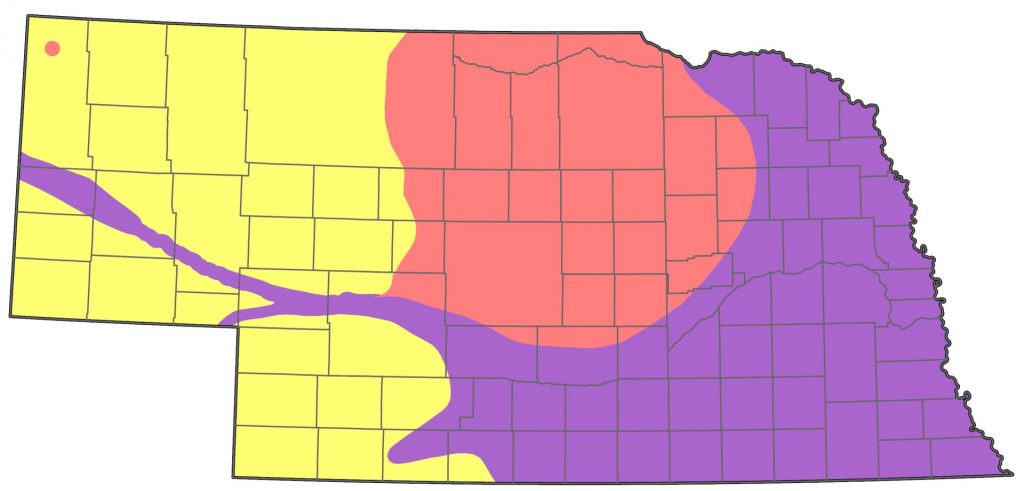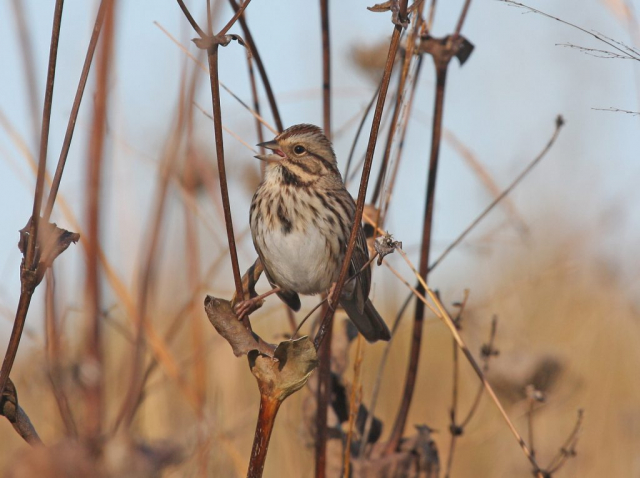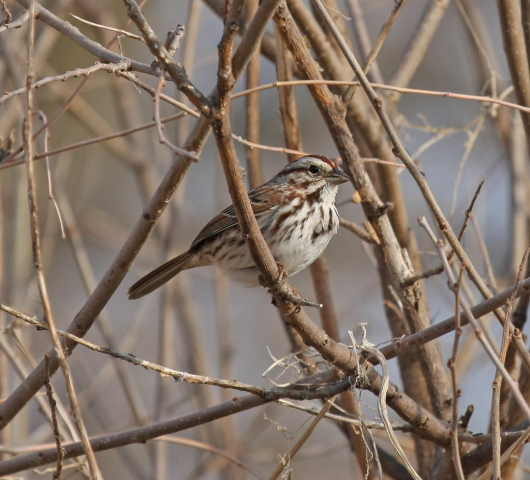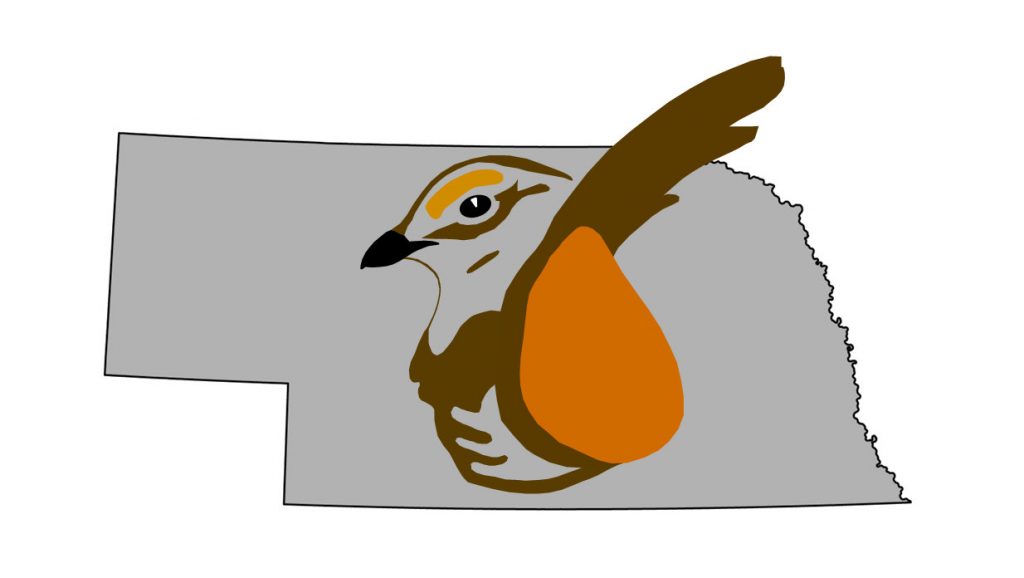Melospiza melodia melodia/euphonia/juddi, M. m. montana
Status: Common regular spring and fall migrant east and east-central, fairly common west-central, uncommon west. Common regular breeder east and east-central, uncommon west-central, rare casual west. Uncommon regular winter visitor south and east and North Platte River Valley, rare elsewhere. Documentation: Specimens: montana: UNSM ZM10614, 7 Dec 1910 Crawford, Dawes Co; juddi: UNSM ZM13070, 9 July 1972 Lancaster Co (Cink 1975); melodia: UNSM ZM17018, 5 May 1994 Lincoln, Lancaster Co.
Documentation: Specimens: montana: UNSM ZM10614, 7 Dec 1910 Crawford, Dawes Co; juddi: UNSM ZM13070, 9 July 1972 Lancaster Co (Cink 1975); melodia: UNSM ZM17018, 5 May 1994 Lincoln, Lancaster Co.
Taxonomy: As many as 52 subspecies have been named, but current authors recognize 24 (Arcese et al 2020, Gill et al 2022), 25 (Patten and Pruett 2009, Clements et al 2016), or 39 (Pyle 1997). Arcese et al (2020), following Patten and Pruett (2009), divided the 24 subspecies they recognized into five groups, only one of which, their “Great Basin to Eastern North America” group, contains subspecies likely to occur in Nebraska. This group, referred to as “Chocolate Song Sparrows” by Wright (2019), has the following subspecies: melodia (including juddi and euphonia), breeding throughout the eastern part of the species’ range excepting parts of the mid-Atlantic Coast, west through the Great Plains and Prairie Provinces, wintering in the southeast USA south to Florida; atlantica, breeding in Atlantic Coast salt marshes from New York south; and montana, breeding throughout the Rocky Mountains and Great Basin regions from southeast Washington east to north-central Montana and south to eastern California and northern New Mexico, with many individuals resident, but northernmost birds migrating south to Baja California and Sonora in winter.
Two subspecies were listed by AOU (1957) as breeding in Nebraska: eastern euphonia in the Missouri Valley and northern juddi along the northern edge of the state. As outlined above, Arcese et al (2020) merge both euphonia and juddi into eastern melodia, considering the differences between the three merely clinal. A specimen (UNSM ZM13070) collected by Cink (1975) in Lancaster Co was found by R.B. Payne to be indistinguishable from a series of juddi at the University of Michigan Museum of Zoology; Cink concluded that the recent arrival of Song Sparrows in Lancaster Co may have been due to a southward spread of juddi rather than westward spread of euphonia. Presumably the increasing number of Song Sparrows summering in most of Nebraska away from the north and east are melodia/juddi also, but there is no information available. In Wyoming, Song Sparrows on the eastern plains are melodia (Faulkner 2010, see Arcese et al 2020), and Song Sparrows observed in the Black Hills of South Dakota in Jun 2024 were considered to be melodia-like (Rick Wright, personal communication). Most of western Nebraska has previously had few if any breeding Song Sparrows until recently (see Summer).
Subspecies montana breeds in the mountains of Wyoming and Colorado and occurs in low numbers as a migrant in the Nebraska Panhandle; Bent (1968) stated it occurs “Casually in migration east to Crawford”. Rosche (1982) stated that “very dark reddish-brown birds” occur occasionally during fall migration in the northwest, presumably of “northwestern” races. The 20-25 records since 1995 for eastern Wyoming, northeastern Colorado, and western Nebraska, all for Sep-Mar (eBird.org, accessed Dec 2023) suggest montana moves out of the higher elevations onto the plains in small numbers during winter; Arcese et al (2020) note that most montana are resident with some movement south from northern parts of the summer range (see Winter).
Subspecies montana may breed or have bred in the Nebraska Panhandle; Dunn and Alderfer (2017) include extreme southwestern Nebraska in the summer range of montana, and Rosche (1994) stated that the “only known habitat in western Nebraska with summering Song Sparrows” was at Oliver Reservoir, Kimball Co. Patten and Pruett (2009) show the summer range of montana extending eastward to correspond with the Wyoming-Nebraska boundary and southward, excluding the eastern Colorado plains. Faulkner (2010) stated that melodia breeds on the eastern Wyoming plains; perhaps the westward spread of melodia in recent years reached Wyoming via northern Nebraska while Kimball Co, Nebraska retained a breeding outpost of montana only about 11.5 miles from Wyoming.
Subspecies montana occurs in low numbers in the west and west-central in winter; the 18 records range from 5 Sep-28 Mar, with ten of the records Oct-Jan (eBird.org, accessed Dec 2023). The two records for Sep are 5 Sep 2021 Dawes Co, and 26 Sep 2022, one photographed at Rock Creek SRA, Dundy Co “typical of Front Range [Colorado] SOSP” (Mlodinow, eBird.org). There is only one record after Jan: Stateline Island, Scotts Bluff Co 28 Mar 2023. Undocumented but possibly montana were three “dark chestnut with gray napes” at Cochran Lake, Scotts Bluff Co, 27 Oct 1996, and one “reddish with gray coloration” near Fort Robinson SHP, Dawes Co 12 Oct 2004. Best count of purported montana was five at Lake Ogallala, Keith Co 9 Jan 2021.
Subspecies rufina breeds in southeast Alaska and Queen Charlotte Islands and “some birds move south in winter” (Arcese et al 2020), albeit mostly to the Pacific Coast as far south as northern California (Wright 2019) and thus unlikely to occur in Nebraska. Nevertheless, two have been identified in northeastern Colorado, 29 Apr 2016 and 13 Nov 2016 (eBird.org, accessed Dec 2023), the only records east of the Rocky Mountains. These birds were strongly rufous, with a buffy wash on lower flanks, heavy russet breast streaking, and some white on the throat. It is possible these northeastern Colorado birds were of the “Rusty Song Sparrow” group, subspecies merrilli, which breeds as far east as central Montana, where its range meets that of montana (Wright 2019).
There is a specimen UNSM ZM7540 (wing 69 mm, tail 76 mm) collected 23 Oct 1890 at Lincoln, Lancaster Co that was identified as an example of fallax, a subspecies with a confusing taxonomic history but currently understood to be resident in southwest Utah and southeast Nevada (Rising 1996, Byers et al 1995, Arcese et al 2020). The range ascribed to it by Baird in his original description included a mix of the currently understood ranges of fallax and the at-the-time unnamed montana (Arcese et al 2020). Despite the large tail length measurement (76 mm) of the UNSM fallax specimen, we believe this is a long-tailed example of montana, whose tail length reaches 75 mm (Pyle 1997).
The identities of Song Sparrows wintering in Nebraska is conjectural; all subspecies discussed above (melodia/juddi/euphonia, montana/merrilli, and rufina are possible (Bent 1968, Rapp et al 1958). As noted by Wright (2019), however: “… like all non-insular, non-sedentary Song Sparrows, [none] should be identified with certainty in the field away from the core of the breeding areas.” It is also possible that some Nebraska summering birds are resident, particularly juddi, which is at the southern edge of its breeding range in Nebraska.
Spring: Song Sparrow occurs statewide during migration, although it is uncommon westward (Rosche 1994). Arrival and departure dates are difficult to determine due to the presence of wintering and summering birds. Examination of available data suggests however that spring migration is in progress by mid-Mar and is essentially concluded around the end of Apr. The last migrant at Box Butte Reservoir, Dawes Co was noted 5 May 1994 (Rosche 1994). First singing birds in 2012 were in Hamilton Co 11 Mar and at Fontenelle Forest, Sarpy Co 14 Mar, and 11 Mar 2021 in Stanton Co.
- High counts: 250 at Funk WPA, Phelps Co 18 Apr 1999, 127 in Hall Co 11 May 2002, 76 at Fontenelle Forest, Sarpy Co 1 Apr 2017, 65 at Funk WPA 6 May 2000, and 63 at DeSoto NWR, Washington Co 10 Apr 2021.
Summer: Available evidence suggests that breeding is a relatively recent phenomenon in Nebraska. Bruner et al (1904) speculated that “a few breed, especially in northern Nebraska,” although no evidence was provided. AOU (1957) stated that subspecies juddi bred in extreme northern Nebraska, citing as locations Sioux County and Dakota City. Sharpe (1967) found a nest with three young Song Sparrows in Sowbelly Canyon, Sioux Co 18 Jun 1966, but unfortunately these juveniles were not identified to subspecies (Cink 1975). Rapp et al (1958) made no mention of breeding, describing Song Sparrow as a “common migrant and winter resident throughout the state”. The first indication of nesting was made by Wood (1965), who found a nest near Plattsmouth; the nest was not conclusively identified as that of a Song Sparrow, however, and may have been that of a Brown Thrasher (Cink 1975). At about the same time an apparently isolated group of summering Song Sparrows was found in the Platte River Valley in Polk Co in 1956 and 1957 by Short (1961). Breeding was first documented in 1972 with a nest and young at Wagon Train Lake, Lancaster Co by Cink (1975), who suggested that Song Sparrow was increasing its range as a breeding bird at least partially as a result of the establishment of reservoirs and irrigation infrastructure. Song Sparrows reported on BBS routes 1967-77 were virtually restricted to the east and north, with 86% of the birds in those areas. In following years, a nest with eggs was found in Johnson Co 14 May 1981 (Ducey; Mollhoff 2022) and a nest with young in Hall Co 7 Jun 2005 (Mollhoff 2022).
Mollhoff (2001) showed summer distribution essentially restricted to the east and east central, but by 2011 (Mollhoff 2016), the range had continued to expand westward by about 100 miles, with reports west to the east edge of the Panhandle, notably in the North Platte River Valley and Niobrara River Valley. These breeding bird atlas data suggest a westward range expansion, rather than, or perhaps as well as, a north-south one as suggested by the presence of juddi Song Sparrows in Lancaster Co (Cink 1975). By 2006, it was “abundant” along the Platte River in Lincoln Co. An “apparent juvenile” was netted at Lake Ogallala, Keith Co 26 Jun 2000 (Brown and Brown 2001). BBS trend analysis (Sauer et al 2020) shows a strong annual increase of 5.1% (95 C.I.; 3.61, 6.65) statewide 1966-2019.
Apart from Sharpe’s (1967) discovery of a nest with young in Sioux Co, there have been few Panhandle or western Sandhills reports until recently. Rosche (1994) stated that this species is “not at all a common bird anywhere in western Nebraska at any time of the year,” and noted that the “only known habitat in western Nebraska with summering Song Sparrows” was at Oliver Reservoir, Kimball Co; these Kimball Co breeders at Rosche’s time were probably the western subspecies montana (Dunn and Alderfer 2017). The only recent reports from Oliver Reservoir, Kimball Co, are of singles there 26 Jun and 27 Aug 2019, and two on 21 Jun 2024. Since then, concentrations of reports have been in the Pine Ridge, Scotts Bluff Co, and Smith Lake WMA, Sheridan Co. Pine Ridge reports increased from around 2010, totaling 13 as of Aug 2024. One was along Edgemont Road, Sioux Co 22 JUn 2024. Two were singing at Agate Springs Ranch, Sioux Co 14 Jun 2021 and one was there 29 Jun 2024. There are several recent summer reports for Scotts Bluff Co, including one on 9 Aug 2017, five in 2019, singles in 2020 at Carter Canyon 5 Jun and Wildcat Hills NC 22 Jun, six at Stateline Island 14 Jun 2021 and one there 18 Jul, and one at Scotts Bluff NM 26 Jun 2021. Otherwise in the North Platte River Valley westernmost reports are near Oshkosh, Garden Co 19 Jul 2009, Lisco, Garden Co 12 Jun 2018, and at Broadwater, Morrill Co 2 Jun 2016. Five were at Smith Lake WMA, Sheridan Co 1 Jul 2017, three on 8 May 2014, 13 Aug 2017, singles 23 May and 15-16 Jun 2018, 20 Jul 2019, and two on 29 Jun 2021. Reports from Crescent Lake NWR, Garden Co are 3 Jun 2017, 17 Jun 2006, and 11 JUn 2024. On 19 Jun 2010, one was found on a BBS route near Dalton, Cheyenne Co 3 Jul 2003, one was along Lodgepole Creek, Cheyenne Co 10 Aug 2017, and one was in Grant Co 7 Jul 2017.
- Breeding phenology:
Singing began 21 Feb 2000 near Ames, Dodge Co
Nest building: 19 Apr-28 May
Eggs: 15 May-8 Jun
Nestlings: 7 May-4 Jun
Fledglings: 10-24 Jun
Fall: Migrants become apparent in early Aug and decline in numbers by late Nov. Before the species became a breeder in the Keith Co area, Rosche (1994) listed an early fall date of 8 Aug. The 40 in Hamilton Co 14 Aug 2011 were probably early migrants. Earlier Aug dates are suggestive of breeding (see Summer).
Northernmost recent later dates are 1 Jan 2020 Boone Co, 1 Jan 2023 Boone Co, 2 Jan 2025 Pants Butte, Sioux Co, 3 Jan 2022 Crawford, Dawes Co, 3 Jan 2025 Fort Robinson, Sioux Co, 3 Jan 2025 Agate, Sioux Co, and 5 Jan 2020 Antelope Co. For later dates see Winter.
- High counts: 75 at Rock Creek SRA, Dundy Co 17 Oct 2020, 68 along Corporation Road 11, Harlan Co 14 Dec 2023, 61 at Kramper Lake, Dakota Co 16 Oct 2020, 55 at Harvard WPA, Clay Co 25 Sep 1996, 52 at Lincoln Saline Wetlands NP, Lancaster Co 22 Oct 2024, and 50 at N. P. Dodge Park, Douglas Co 30 Nov 2020.
Winter: CBC and eBird data (eBird.org, accessed Dec 2023) show that in Dec most Song Sparrows are on their winter range from the counties in the North Platte and Platte River Valleys southward, although generally absent from the southwest and the southern Panhandle. One lingered at a Valentine, Cherry Co feeder 14-24 Dec 2022. Overwintering birds (Jan-Feb) in smaller numbers may occur anywhere in the winter range where open water in the form of springs, seeps, or small streams exists.
Elsewhere, mid-winter reports (6 Jan-Feb) in the north and west are few; 11 Jan 2025 Brown Co, 29 Jan 2021 Whitney Lake, Dawes Co, 1 Feb 2019 Dry Creek WMA, Holt Co, 6 Feb 2021 Agate Fossil Beds, Sioux Co, 13 Feb 2016 Agate Fossil Beds, Sioux Co, 15 Feb 2015 six in Boone Co, 25 Feb 2023 Knox Co, and 31 Dec 2022, 2 Feb 2025 Holt Co, 17 Feb 2012, and 21 Feb 2011 Calamus Reservoir in Garfield Co.
The highest CBC count is 135 at Omaha in 1967, followed by Harlan County Reservoir with 132 in Dec 2023; during the 10 years of CBCs 2005-2006 through 2014-2015, average number of Song Sparrows counted was 29.7 at Omaha, 16.1 at Lake McConaughy, and 8.1 at Scottsbluff.
Images
Abbreviations
BBS: Breeding Bird Survey
CBC: Christmas Bird Count
NC: Nature Center
NM: National Monument
NP: Nature Park
NWR: National Wildlife Refuge
SHP: State Historical Park
SP: State Park
SRA: State Recreation Area
UNSM: University of Nebraska State Museum
WMA: Wildlife Management Area (State)
WPA: Waterfowl Production Area (Federal)
Literature Cited
American Ornithologists’ Union [AOU]. 1957. The AOU Check-list of North American birds, 5th ed. Port City Press, Baltimore, Maryland, USA.
Arcese, P., M.K. Sogge, A.B. Marr, and M.A. Patten. 2020. Song Sparrow (Melospiza melodia), version 1.0. In Birds of the World (A. F. Poole and F. B. Gill, Editors). Cornell Lab of Ornithology, Ithaca, NY, USA. https://doi.org/10.2173/bow.sonspa.01.
Bent, A.C. 1968. Life histories of North American Cardinals, Grosbeaks, Buntings, Towhees, Finches, Sparrows, and allies. Bulletin of the United States National Museum 237. Three Parts. Dover Publications Reprint 1968, New York, New York, USA.
Brown, C.R., and M.B. Brown. 2001. Birds of the Cedar Point Biological Station. Occasional Papers of the Cedar Point Biological Station, No. 1.
Bruner, L., R.H. Wolcott, and M.H. Swenk. 1904. A preliminary review of the birds of Nebraska, with synopses. Klopp and Bartlett, Omaha, Nebraska, USA.
Byers, C., J. Curson, and U. Olsson. 1995. Sparrows and Buntings. A guide to the sparrows and buntings of North America and the World. Houghton Mifflin Company, Boston, Massachusetts, USA.
Cink, C.L. 1975. The Song Sparrow as a Nebraska Breeding Bird. NBR 43: 3-8.
Clements, J. F., T. S. Schulenberg, M. J. Iliff, D. Roberson, T. A. Fredericks, B. L. Sullivan, and C. L. Wood. 2016. The eBird/Clements checklist of birds of the world: v2016, accessed 30 January 2018.
Dunn, J.L., and J. Alderfer. 2017. National Geographic Field Guide to the Birds of North America. Seventh Edition. National Geographic, Washington D.C.
Faulkner, D.W. 2010. Birds of Wyoming. Roberts and Company, Greenwood Village, Colorado, USA.
Gill, F., D. Donsker, and P. Rasmussen (Eds). 2022. IOC World Bird List (v 12.2). Doi 10.14344/IOC.ML.12.2. http://www.worldbirdnames.org/.
Mollhoff, W.J. 2001. The Nebraska Breeding Bird Atlas 1984-1989. Nebraska Ornithologists’ Union Occasional Papers No. 7. Nebraska Game and Parks Commission, Lincoln, Nebraska, USA.
Mollhoff, W.J. 2016. The Second Nebraska Breeding Bird Atlas. Bull. Univ. Nebraska State Museum Vol 29. University of Nebraska State Museum, Lincoln, Nebraska, USA.
Mollhoff, W.J. 2022. Nest records of Nebraska birds. Nebraska Ornithologists’ Union Occasional Paper Number 9.
Patten, M.A., and C.L. Pruett. 2009. The Song Sparrow, Melospiza melodia, as a ring species: patterns of geographic variation, a revision of subspecies, and implications for speciation. Systematics and Biodiversity 7.1: 33-62.
Pyle, P. 1997. Identification Guide to North American Birds. Part I, Columbidae to Ploceidae. Slate Creek Press, Bolinas, California, USA.
Rapp, W.F. Jr., J.L.C. Rapp, H.E. Baumgarten, and R.A. Moser. 1958. Revised checklist of Nebraska birds. Occasional Papers 5, Nebraska Ornithologists’ Union, Crete, Nebraska, USA.
Rising, J.D. 1996. A guide to the identification and natural history of the sparrows of the United States and Canada. Academic Press, New York, New York, USA.
Rosche, R.C. 1982. Birds of northwestern Nebraska and southwestern South Dakota, an annotated checklist. Cottonwood Press, Crawford, Nebraska, USA.
Rosche, R.C. 1994. Birds of the Lake McConaughy area and the North Platte River valley, Nebraska. Published by the author, Chadron, Nebraska, USA.
Sauer, J.R., W.A. Link and J.E. Hines. 2020. The North American Breeding Bird Survey – Analysis Results 1966-2019. U.S. Geological Survey data release, https://doi.org/10.5066/P96A7675.
Sharpe, R.S. 1967. The 1966 nesting season. NBR 35: 29-38.
Short, L.L., Jr. 1961. Notes on bird distribution in the central Plains. NBR 29: 2-22.
Wood, D. 1965. Song Sparrows nesting at Plattsmouth. NBR 33: 14.
Wright, R. 2019. Sparrows of North America. Peterson Reference Guide. Houghton Mifflin Harcourt, Boston and New York.
Recommended Citation
Silcock, W.R., and J.G. Jorgensen. 2025. Song Sparrow (Melospiza melodia). In Birds of Nebraska — Online. www.BirdsofNebraska.org
Birds of Nebraska – Online
Updated 18 Mar 2025, map updated 27 Jul 2023


